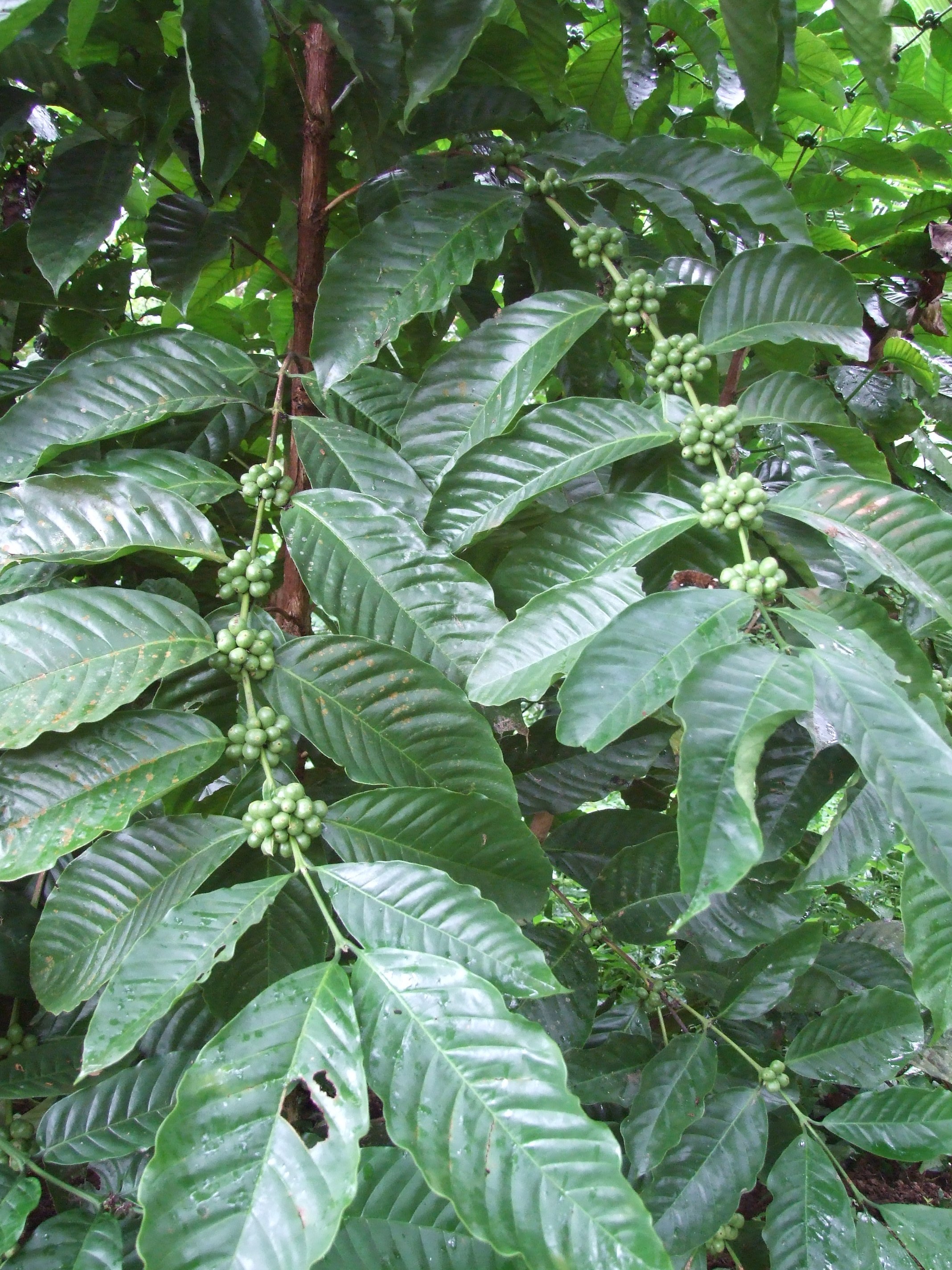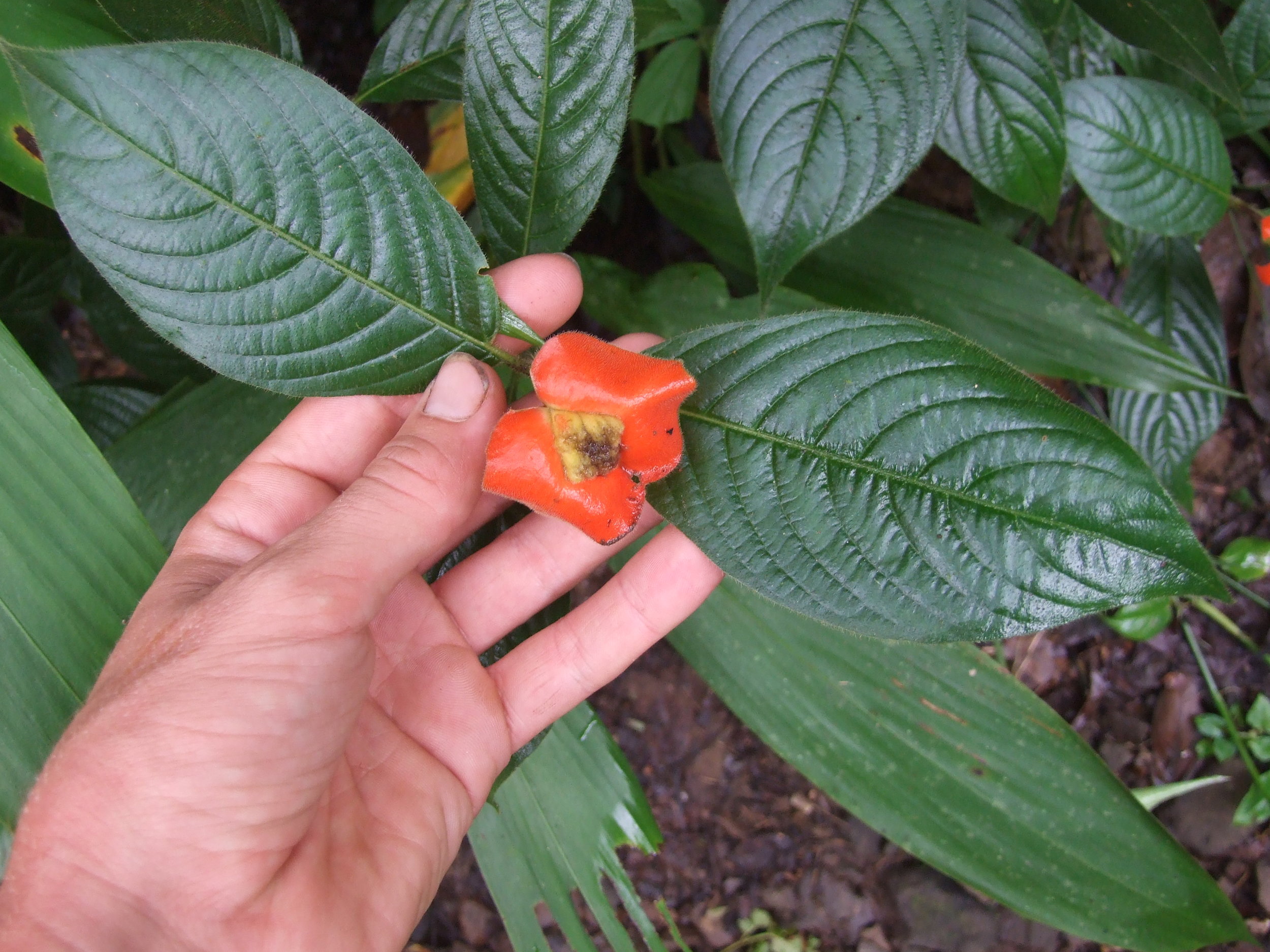Randia formosa is a memeber of the Rubiaceae family, native to Brazil. Is a small tree related to gardenia and coffee and Psychotria spp, among others. The tree / shrub has a has fragrant, white flowers similar in aroma to the gardenia. The tree doesn't get much taller than eight feet. The fruit is a yellow capsule with an almost brittle shell, similar in shape, although smaller in size, to the pomegranate (Punica granatum). Upon breaking open the capsule, one will find dark, jam-like pulp embedded with numerous seeds. The pulp has a taste similar to that of blackberry jam, or some other jam, thus the name.
Coffea canephora - Canephora Coffee
BACKGROUND, ORIGIN AND DISTRIBUTION
Coffea canephora, otherwise known as Robusta coffee, is native to Central and Western Sub-Saharan Africa. I took this photo in the Northern Caribbean Islands in Panama where we were planting it as a shaded understory intercrop to larger hardwoods and crown bearing fruit trees. .
Native to the upland forests of Ethiopia, Coffea robusta was only recognized as a coffee species in 1897, almost 100 years after Coffea arabica.
Most Robusta coffee today is grown in Vietnam, where it was introduced by French colonists in the late 19th century.
USES AND ETHNOBOTANY
40% of the coffee in the world is Robusta coffee. Robusta has a greater crop yield and more caffeine then Arabica coffee. This species is also less succeptible to pests and diseases then Arabica, therefore relying on less herbicide and pesticides in commercial cultivations.
That Robusta coffee plants are less susceptible to pest and diseases begs the question of weather or not the plant may have more mycorrhizal associations with beneficial fungi, thereby improving overall resilience and health.
PROPAGATION AND CULTIVATION
Coffee can be easily grown from seed. Seeds benefit from a light fermentation over a few days in their skin prior to germination. The pre-fermentation basically mimics the natural process that fruit goes through after it matures and drops to the ground in the tropics. After the light fermentation seeds can then be rinsed in clean water, removing any residual pulp.
Coffee seedlings can often be found germinating around the base of a fruit bearing plant. Reportedly the plant has naturalized in a number of countries throughout the world including Borneo, French Polynesia, Costa Rica, Nicaragua, Jamaica, and the Lesser Antilles.
Rubiaceae, Psychotria poeppigiana, hot lips, labios de puta
BACKGROUND< ORIGIN AND DISTRIBUTION
Native to the forests of Panama, this photo was taken in Soberania national park on the Pacific Side. The species ranges widely in the tropical Americas, from from Chiapas, Oaxaca, Tabasco and Veracruz in Mexico to the very north of Argentina. It does not occur on the Pacific side of the American cordillera however, and is thus absent from El Salvador and Chile. It is probably also absent from Uruguay and Paraguay.
PROPAGATION AND CULTIVATION
I have propagated this Psychotria poeppigiana from seeds and cuttings collected in the dry tropical forests on the Pacific Coast of Panama.
USES AND ETHNOBOTANY
This species has been used as a hunting fetish, as a magical talisman to facilitate hunting. The leaves and flowers would be placed in a bundle and tied to the collar of dogs when hunting taipir. In Suriname the plant is crushed then boiled, the resulting liquid can be used as wash for headaches. This same preparation can be used as an external wash for sprains, rheumatism, muscular pains and contusions.
The Wayana indians of Suriname use bark raspings from the stem and rub it on a skin rash known as "poispoisi". The red, sap-filled inflorescence are used for an antalgic to treat earache, administered by dropping the sap into the ear canal. The inflorescence is used to remedy whooping cough.
This species of psychotria has also been used as a P. viridis analogue in ayahuasca, containing significant amounts of DMT.
Psychotria viridis - Chacruna
OVERVIEW
Psychotria viridis is a perennial shrub of the Rubiaceae family. In the Quechua languages it is called chacruna or chacrona. In Quechua, chaqruy is a verb meaning "to mix". P. viridis grows to a height of approximately 5 m (16 ft). Its branches span a diameter of about 2 m (6 ft 7 in)
ORIGIN AND DISTRIBUTION
Neotropics. Amazon basin, South America.
USES AND ETHNOBOTANY
This species of Psychotria is used by indigenous peoples of western Amazonia, primarily as an additive in the preparation of a hallucinogenic drink ayahuasca, also called yage, employed for healing and divination. Although in some instances ayahuasca can be prepared in the absence of Psychotria, the addition of the plant greatly enhances the visionary effect of the brew due to the significant amounts of DMT present in its leaves. DMT, or N, N-dimethyltryptamine, is a tryptamine alkaloid.
Other plants with significant quantities of DMT include: Mimosa tenuiflora (=M. hostilis), Anadenanthera peregrina, Acaciapolyacantha, A. cornigera, A. maidenii, A. nubica, A. plebophylla, A. polyantha, A. senegal, A. simplicifolia), Calliandra spp., Desmodium spp. Mucuna pruriens (Fabaceae), Virola peruviana, V. elongata (=V. heiodora) Epenña, Yakeé (Myristicaceae); Banisteriopsos argentea, B. rusbyana (Malpighiaceae); Prestonia amazonica (Apocynaceae); Psychotria peoppigiana, adn P. psychotriaefolia (Rubiaceae); Arundo donax, Phalaris arundinacea, Phragmites austraiis (Poaceae) and Zanthoxylum spp (Rutaceae).
PROPAGATION
Psychotria viridis is hardy in USDA zone 10 or higher. The plant is fairly easy to propagate from seeds, stem cuttings, or leaf cuttings. Some resources state that the plant is extremely difficult to propagate from seed (as low as 1%!), but I have not found this to be the case. I would probably note that treating the seeds in their own fermenting fruit pulp can improve germination.
The plant does, however, reproduce most readily from fresh leaf cuttings. I have looked for evidence of leaves dropping off the plant and self-propagating as such. I have noticed that some plants will produce seed heavily for a while, then the bulk of the shrub will slowly die off, sending up a few new shoots in succession from the base of the trunk.
P. viridis leaf cutting propagation.








